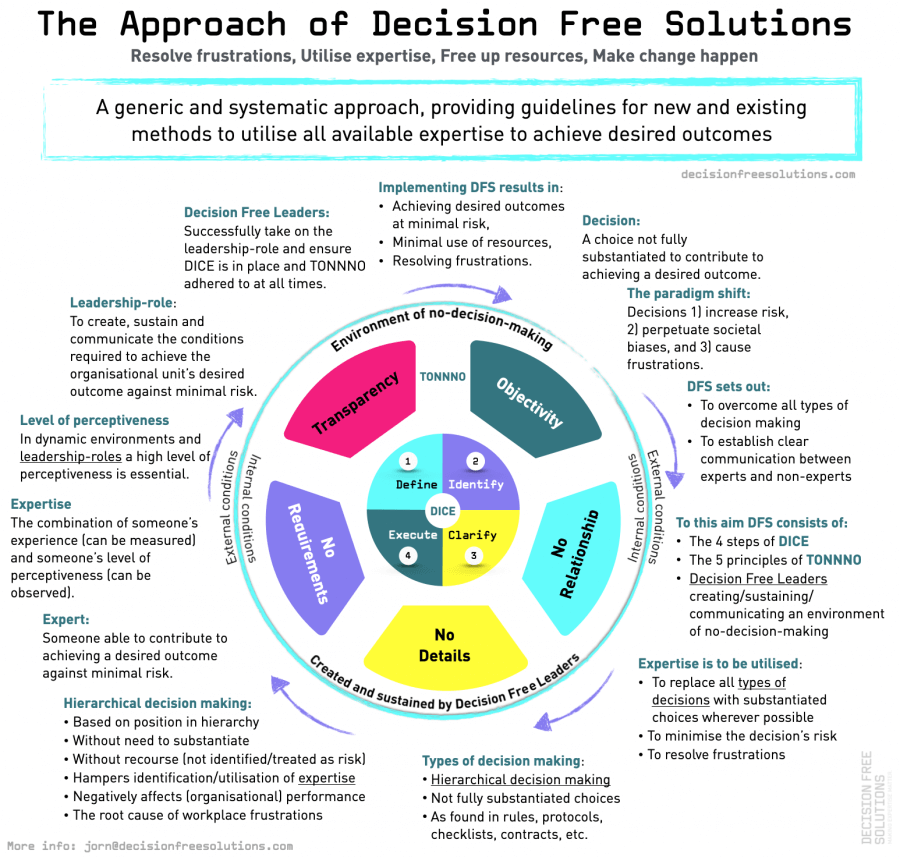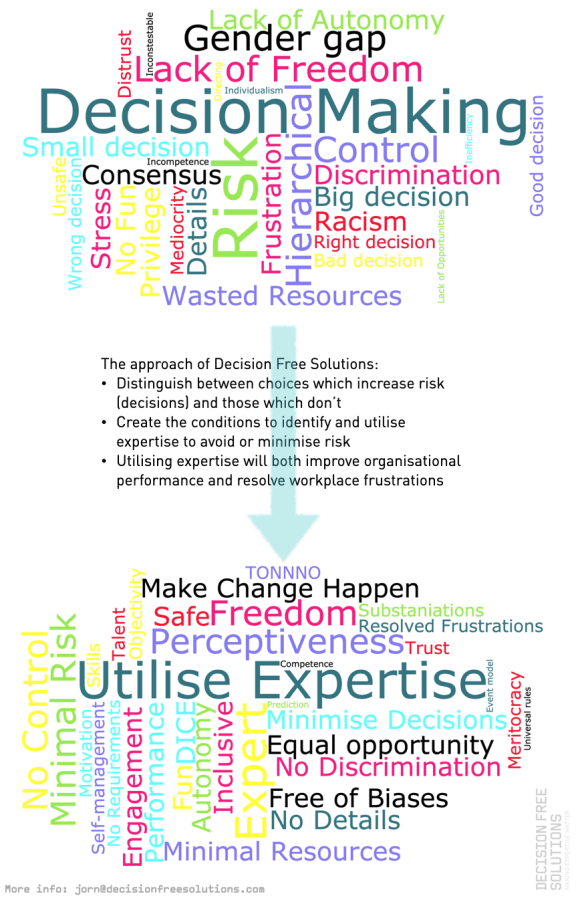An original article by Decision Free Solutions
Introducing the approach of Decision Free Solutions
The full article is available as PDF. For the PDF file of this report click on the download-icon on the left-hand side of this page or simply click here.
Introduction and management summary
Organisations are successful when they achieve their organisational goals at minimal risk, using minimal resources. Each successful organisation does so in its own way. But to be successful always comes down to having the conditions in place to optimally utilise available expertise.
In achieving desired outcomes organisations constantly have to make choices. The approach of Decision Free Solutions (DFS) identifies that there are only two types of choices to be made: choices which increase the risk the desired outcome will not be achieved (or only using many more resources than minimally required), and choices which don’t increase this risk.
The latter type of choice is made by experts. To them, in their field of expertise, what needs to be done is obvious, and, in fact, no longer involves a choice. Which leaves organisations with the choices which are not fully substantiated, and which do increase risk. Organisations have a special word for this type of choice. They call it a decision.
Recently, in recognition of an increasingly dynamic world, different approaches to decision making have been proposed: from traditional “hierarchical decision making” to shared, consent-based, distributed, integrative or pushed-down decision making. In all instances, to reduce the inherent risk associated with decisions, more relevant expertise is brought into the decision making process.
DFS, based on a clarified definition of what a “decision” actually is, sets out to systematically minimise 1) decision making and 2) the risks associated with them. DFS achieves this by creating the conditions to fully utilise available expertise. For this, two central challenges have to be overcome:
- The prevalence of all types of decision making hampering the use of expertise (hierarchical, and as found in rules, procedures, protocols, checklists and contracts)
- Ensuring the clear communication between experts and non-experts to prevent mechanisms of control and decision making kicking in
DFS provides guidelines — by way of four steps (DICE), five principles (TONNNO) and the role of the Decision Free Leader — to systematically utilise all available expertise to achieve desired outcomes. These guidelines can be used to improve existing operational methods and philosophies (e.g., Agile, Holacracy, “self-management,” the existing “modus operandi”), or to device new ones.
DFS’s motto is “Resolve frustrations, Utilise expertise, Free up resources, Make change happen”. DFS doesn’t prescribe what it is you have to do (and how), DFS guides you and tells you what to pay attention to along the way. Implementing DFS is an antidote to the fragility, the madness, the wasted resources, the many frustrations — from lack of autonomy, trust and freedom, to the grievances of racism and discrimination — and the risk involved in how most systems and organisations operate.
As DFS is a wholly logical approach, it requires no assumptions, no leap of faith, no degree in semantics, no contracts, no special training — and it is entirely for free. DFS puts expertise, and thus people and their well-being, central. DFS is where “the new way of working” begins.


Figure 1. Graphical summary of the approach of Decision Free Solutions.
What makes the approach of DFS unique?
To optimally utilise available expertise is not a new goal. There are a number of existing approaches and management philosophies that have a similar or identical aim. But none of these approaches is built on a paradigm shift on how to approach decision making.
Through the mere clarification of a single word — decision — DFS is not only able to explain the success of a range of both pioneering organisations and existing methodologies, but also to provide suggestions for further improvements [10]. Through this new perspective, and simply by following the logic, DFS is able to unlock an organisation’s full potential, and offer new powerful insights when it comes to predicting performance, leadership, and even through which mechanisms racism and discrimination enter organisations [5,6,12].
The approach of Decision Free Solutions’ many unique elements are a direct result of “decision making” playing such a pivotal role in achieving organisational success, and the power of language itself (as it is through language that we — quite literally — see the world).
The following is unique to the approach of Decision Free Solutions :
- DFS’ starting premise is making a rigorous distinction between choices which increase risk (decisions), and choices which don’t. As the latter aren’t technically decisions, it proposes a paradigm shift: decisions need to be avoided, replaced, minimised.
- As decision making not only increases risk but is also affected by (societal) biases, implementing DFS not only improves performance, but also resolves (workplace) frustrations from lack of autonomy, trust and freedom to the grievances of racism and discrimination.
- The approach of DFS is both logical, generic and systematic:
- It can be implemented in any field, at any level, at any scale, both gradually and reversibly (from organisations to management to procurement to sales to birthing to whatever)
- Without the need for courses, certificates or contracts or having to buy into multiple programs requiring constant clarification by costly consultants
- Without requiring a restructuring, a reorganisation, the immediate and full departure of current practices or an adherence to pre-cooked policies, procedures and templates
- Without demanding a leap of faith or relying on “experimentation” — if you see the logic you can go and run with it at a pace of your own choosing
- DFS can be used to both develop new methods as well as to improve existing ones, offering logic and guidelines to arrive at a method, approach or procedure which is best suited to achieve the desired outcome within a given environment — logic and guidelines which allow any change or (cultural) transformation to be sustainable
- DFS allows for the identification of both (non-)expert individuals and organisations through the observation of behavioural characteristics, and therefore for the prediction of (non-)performance.
- DFS — because of its “decision making paradigm shift,” and its ability to identify expertise (and thus predict performance) by observation — is a unique and powerful tool for research in a vast range of fields (e.g. organisations, management, leadership, “new way of working”)
What is the approach of Decision Free Solutions for?

The approach of DFS is generic: It can be applied in any situation where assistance is required to achieve a particular desired outcome. By optimally utilising expertise the approach aims to fully achieve this desired outcome, and to do so at minimal risk.
The approach of DFS is systematic: it is built on logic and the clear definition of terminology which is of central importance. This logic can be used to develop new methods from the ground up (e.g. in organisations, management, procurement, sales, healthcare, birthing), but it can also be used to critically assess (and improve) existing methodologies and ways of working.
The approach of DFS offers guidelines: it consists out of four steps (DICE), five principles (TONNNO) and the concept of the “Decision Free Leader”.
The motto of the approach of Decision Free Solutions is: Resolve frustration, Utilise expertise, Free up resources, Make change happen:
- By creating the conditions to optimally utilising expertise a wide range of frustrations can be resolved. Not only the frustration of not achieving the desired outcome — or achieving it using many more resources than required — but also the frustrations felt by those whose expertise is not (fully) utilised. These frustrations range from lack of autonomy, responsibility, freedom, trust and fun, to the grievances of discrimination and racism [12]. DFS, focussing on utilising expertise, is a human-centred approach.
- Through the utilisation of expertise desired outcomes can be achieved more efficiently, and at minimal risk — and thus using the minimal amount of resources.
- The combination of non-ambiguous desired outcomes and clear communication between experts and non-experts does away with the need for a costly system of control (“overhead”). This system of control is a logical reflex to minimise risks when desired outcomes are not transparent and expertise is not identified and utilised. In absence of this need for control significant amounts of resources can be freed up.
- Through the combination of minimising the need for resources to achieve a particular desired outcome, and freeing up resources by reducing overhead, DFS contributes to removing a critical bottleneck — sufficient resources — in making change happen.
The starting premise of the approach of Decision Free Solutions is that a distinction must be made between decisions which increase risk, and decisions which don’t. DFS sets out to utilise expertise to either replace decisions with substantiated choices, or to minimise the risk associated with those which cannot be avoided. This remaining risk is to be considered for risk management.
Implementing DFS in any field (e.g., procurement), or any system (e.g., organisations), results in a shift away from decision making, risk and all of its related consequences, and towards improved performance in actually achieving desired outcomes, and the resolution of a range of frustrations (see Figure 2).

Figure 2.
To read the rest of the article download the PDF file (or send us an email).